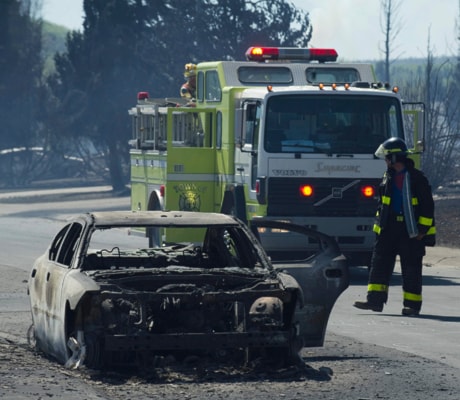SLAVE LAKE — Thousands of people who had to flee their northern Alberta community as a wind-whipped wildfire crackled through their town are waiting to hear if their homes are still standing.
Police say nearly one-third of Slave Lake has been destroyed or has been damaged. Mayor Karina Pillay-Kinnee says the town’s government building and library fell to the flames. She also says that contrary to earlier reports, the RCMP detachment and school are still standing.
She does confirm that half the homes in the hardest-hit residential area have been damaged or destroyed.
There have been no reports of deaths or injuries.
One man who decided to leave even before a mandatory evacuation of the town’s 7,000 residents was ordered around suppertime Sunday said the speed of the fire caught everyone by surprise.
Scott Sieben said winds gusting up to 100 kilometres an hour fanned the flames. “It was almost like an imaginary hand just pulling it along.”
He said the blaze was so intense it was “like watching an oil fire. Black as black can be.”
“It was so out of control,” said Sieben, who, with his wife, Leonna, was safe “far, far away” from the fire. “I’m sure at one point there was a cloud that spanned two miles.”
The town’s website features a warning in bold red letters telling residents to leave, where they should go and warning anyone remaining not to use water for anything except firefighting.
“Fire has breached the town of Slave Lake boundary along the southern portion ... ”
The website ends abruptly.
Residents were initially advised to go to green spaces, open areas such as parking lots or the beach ringing the shore of Lesser Slave Lake, a popular recreation area.
But as it became evident that the fire was invading the town nestled on the lake’s southeast corner, they were told to get out on the only highway that was still open. The others had been blocked by heavy smoke and flames.
Rob Genaille, his wife and two teenage children had about 15 minutes to pack one suitcase and throw it and some sleeping bags into their hatchback.
They tried to get out of town one way but had to turn back.
“I couldn’t see anything,” Genaille said. “Fire was on both sides of the road.”
He said they spent a few hours in a hotel in Slave Lake before making their way to an evacuation centre. Their fourth-storey hotel room gave them a terrifying look of buildings burning.
“We were watching one hotel ignite. That just basically blew up. We could hear popping, just like explosions,” he said.
“It’s a pretty helpless feeling when you can’t get out of town and the roads are closed. You sit up there and you hope you don’t burn.”
Evacuation centres were set up in the communities of Westlock, Athabasca and the city of Edmonton, 250 kilometres to the south. A separate gym in Athabasca was set up for pets.
Alberta Municipal Affairs said Monday morning that 90 per cent of the town was empty and only essential or firefighting staff remained.
More firefighters were on their way, including a crew from Calgary and about 70 from the Edmonton area. A national heavy urban search-and-rescue team was deployed to Westlock to help manage evacuees.
Nearly 30 patients at the hospital in Slave Lake were transported to facilities in other communities, said John Muir, a spokesman with Alberta Emergency Management.
Social networking also geared up as word of the fire spread, with hundreds posting questions, offers and communicating concern.
Someone identified as Jackie Smith wrote on Facebook: “Anyone needing boys clothes ... please message me. Also have a couch and loveseat I can donate. Also willing to open my door to any evacuees needing a shower or a place to stay.”
Janette Bishop in Edmonton posted: “I have an extra room with a queen-sized bed. Lots of room for kids. Please contact.”
Crews had been working since Saturday to fight two separate fires near the town, but were challenged by the strong winds and warm, dry conditions.
Atco Electric confirmed it was experiencing problems because the fires were damaging transmission lines.
Slave Lake was not the only community in trouble. The Lubicon Lake First Nation at Little Buffalo said it received word that fire was 25 kilometres away. But winds moving in the opposite direction were keeping the blaze at bay in a slow-burning stand of aspen trees.
“Our office has requested the evacuation of elders, children, women and those with health conditions that would be exacerbated by the smoke,” said Chief Bernard Ominayak.
Residents reported that smoke had hit the community and visibility was poor.
Numerous other blazes have been burning throughout Alberta, but the northern part of the province has been particularly hard hit.
An Edmonton radio station reported that two of the biggest oilsands sites north of Fort McMurray were evacuated Monday as an out-of-control forest fire got too close for comfort. Workers said the Canadian Natural Resources operation and Shell’s Albion site were emptied as a precaution.
Alberta Sustainable Resources advised that a 250-square-kilometre fire was burning in the backcountry and across the Athabasca River. The Regional Municipality of Wood Buffalo, which includes Fort McMurray, activated its emergency operations centre.
A wildfire near Peace River forced cleanup operations at the site of a huge oil pipeline spill last month to be suspended. Plains Midstream Canada, the pipeline operator, said the decision to remove workers was made after county officials issued an evacuation order.
The company said it had also shut the flow on its Rainbow pipeline, which carries crude from its Nipisi terminal to Edmonton, as a precaution.
